By Doug Winter – RareGoldCoins.com ……
CoinWeek Content Partner
Liberty Head half eagles were produced from 1839 until they were discontinued in 1908. This long-lived series is becoming popular with collectors who are attracted to these coins because of their history and rarity. This article is an attempt to make sense of the Liberty Head half eagle series for the beginning and intermediate collector.
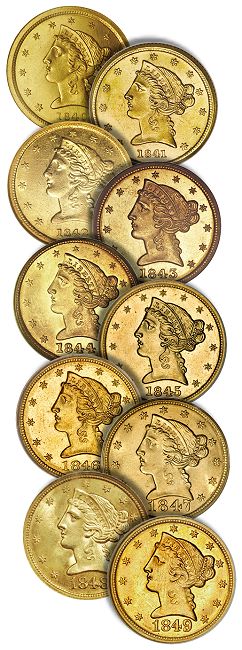 First, let’s take a look at some of the historic background of the series and the half eagle denomination.
First, let’s take a look at some of the historic background of the series and the half eagle denomination.
This was one of the original denominations that was authorized by the Act of 1792 and it was one of three struck in gold, along with the quarter eagle ($2.50) and the eagle ($10.00). The half eagle denomination was the workhorse of these three and the issues from 1795 to 1813 are far more available than the other gold coins of this era. The half eagles from 1814 through 1833 tend to be extremely rare due to large-scale meltings.
In 1839, the half eagle was redesigned by Christian Gobrecht. The design was modified in 1840 and experimented with through 1843. It stayed unchanged until 1866 when the motto IN GOD WE TRUST was added to the reverse. For most collectors, the following types of Liberty Head half eagle are included in their collection:
- First Head; mintmark on obverse. (1839 only)
- Second Head; mintmark on reverse. No Motto. (1840-1866)
- Second Head; mintmark on reverse. With Motto. (1866-1908)
The Liberty Head half eagle series is unique in that it is the only United States gold type struck at seven mints. These are as follows: Philadelphia, Charlotte, Dahlonega, New Orleans, Carson City, San Francisco, and Denver. A novel way to collect this series is to assemble a seven-mint set; this will be discussed later in his article.
I can think of at least seven different ways to collect Liberty Head half eagles. If you are creative, there are probably more but for the sake of brevity, let’s focus on these methods.
1. By Mint
Probably the most popular way to collect Liberty Head half eagles is by mint. To do so, a collector generally focuses on one (or two) of the seven mints that produced this series.
The most popular mint to specialize in is Dahlonega. The half eagles from this mint were produced from 1838 to 1861. There are no major rarities in the Dahlonega half eagle series and this is a set that can be completed in grades that range from Very Fine all the way to Uncirculated. One of the things that is interesting about this set is how affordable the coins are. If a collector wanted to put together a set of the twenty-four major issues in the VF-EF range, this could be done for around $70,000-90,000. A set that featured the Finest Known and Condition Census coins could run well north of $500,000.
The second most popular mint to collect is Carson City. These were issued from 1870 to 1893. This set is impossible to complete in Uncirculated but it could be done in AU55 and better grades. A collector who had a more limited budget could acquire virtually every date in Fine to Very Fine grades and the more affordable later dates (i.e., those from the 1890′s) can be found in higher grades at relatively nominal sums.
Probably the most difficult mint to complete a set from is San Francisco. Virtually every half eagle produced at this mint from 1854 to 1877 is very rare in high grades and most of these are either unknown or extremely rare in Uncirculated. There are very few collectors who specialize in San Francisco half eagles and there are a number of reasons for this. The set is long (coins were issued from 1854 through 1906), full of rarities and it contains coins that are numbingly common (most of the issues from 1879 onwards).
2. By Decade or Year
An interesting way to collect Liberty Head half eagles is by decade. This type was produced during the 1840s, ’50s, ’60s, ’70s, ’80s, ’90s, and 1900s. A “by decade” set appeals to many collectors due to the fact that there is a broad range of coins issued.
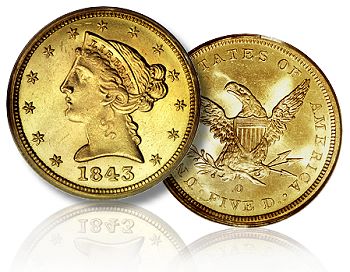 In my opinion, the 1840s would be the most interesting decade to specialize in. There were four mints that produced half eagles during this decade: Philadelphia, Charlotte, Dahlonega, and New Orleans. Virtually all of the coins made during the 1840s are available in circulated grades but most are rare in Uncirculated. What I like about the coins from this decade, besides their historic association, is the fact that many are highly undervalued; more so, I feel, than any other decade.
In my opinion, the 1840s would be the most interesting decade to specialize in. There were four mints that produced half eagles during this decade: Philadelphia, Charlotte, Dahlonega, and New Orleans. Virtually all of the coins made during the 1840s are available in circulated grades but most are rare in Uncirculated. What I like about the coins from this decade, besides their historic association, is the fact that many are highly undervalued; more so, I feel, than any other decade.
Another decade that is full of undervalued, overlooked coins is the 1870s. Nearly all of the coins struck between 1870 and 1876 are rare in all grades (there are a few exceptions such as the 1873) and most of the issues from this decade are very rare to extremely rare in Uncirculated.
An interesting half eagle set is a year set. This would include one example of every year in which Liberty half eagles were produced from 1839 through 1907. The beauty of this set is that in years in which there are rarities, there is always an affordable issue to lessen the cost. As an example, the mintmarked half eagles from 1861 (1861-C, 1861-D, and 1861-S) are all scarce and in higher grades, they are very expensive. But the 1861 Philadelphia half eagle is common and a very nice example can be obtained for around $1,000. There are only a few years in which all the issues are rare and these tend to be the ones (like 1863 and 1864) in which only a limited number of mints were striking half eagles.
3. By Type
I described the three major types of Liberty Head half eagles earlier in this article. For collectors who choose to focus on these three coins, there are are many options.
The initial type was made only in 1839, at the Philadelphia, Charlotte, and Dahlonega Mints. None of these issues is rare although the two mintmarked coins are highly sought-after and very expensive in Uncirculated. An 1839 Philadelphia half eagle is more obtainable and a really nice piece can be found for just a few thousand dollars.
 The No Motto type, struck from 1840 through 1866 contains issues that run the gamut from common to very rare. Most No Motto half eagles (even the common dates) are very hard to locate in Uncirculated grades and there are very few single coins that exist in MS63 and above. For type purposes, it might make sense to look for a common Philadelphia coin from the 1840s or ’50s in AU58 to MS62. Again, a very nice coin can be obtained for just a few thousand dollars.
The No Motto type, struck from 1840 through 1866 contains issues that run the gamut from common to very rare. Most No Motto half eagles (even the common dates) are very hard to locate in Uncirculated grades and there are very few single coins that exist in MS63 and above. For type purposes, it might make sense to look for a common Philadelphia coin from the 1840s or ’50s in AU58 to MS62. Again, a very nice coin can be obtained for just a few thousand dollars.
The With Motto type was made from 1866 until the end of this design in 1908. There are a number of very rare With Motto issues but most of the pieces struck after 1879 are common, even in the lower Uncirculated grades. For a type coin, I’d recommend a common date from the late 19th century in MS63 to MS65 grades. Depending on the date and grade, you’re looking at an expenditure of just a few thousand dollars.
4. Rarities
There are a number of rarities in the Liberty Head half eagles but not nearly as many as in the earlier half eagles that immediately precede this type. First and foremost is the 1854-S, of which there are just four known.
There are other rare issues in this series but none approach the 1854-S. In the Philadelphia issues, the 1875 is by far the key issue. Only 200 business strikes were made and it is believed that around 10 or so are known today. Despite this coin’s extreme rarity, examples have traded in the low six figures. After the 1875, the next rarest Philadelphia half eagles are the 1887 (struck only as a Proof) and the 1863.
The aforementioned 1854-S is, obviously, the great rarity from San Francisco. After this, there is a steep drop-off in terms of rarity. The issues from 1859 through 1867 are all scarce in circulated grades and extremely rare in Uncirculated. By far the rarest of these is the 1864-S. In fact, a strong case can be made for this date being the rarest collectible half eagle of this type. Despite this fact, it is not out of the price range of most collectors.
None of the Charlotte or Dahlonega half eagles is a major rarity as far as the total number known to exist. The key Charlotte issues include the 1842-C Small Date, 1844-C, 1846-C, and 1861-C, while the hardest Dahlonega half eagles to acquire include the 1842-D Large Date and the 1861-D.
Switching focus to the New Orleans issues, the two hardest dates to acquire are the 1842-O and the 1847-O. Both of these are actually affordable in the EF40-AU50 range, scarce but not budget-busting in the middle to higher AU grades and extremely rare in Uncirculated. The Carson City series contains a number of scarce dates such as the 1870-CC, 1872-CC, 1873-CC, and 1878-CC. Again, these are pricey but obtainable in the AU grade range.
In summary, the only Liberty Head half eagle that will prove to be unobtainable is the 1854-S. The other rare dates can be found with patience.
5. Proofs
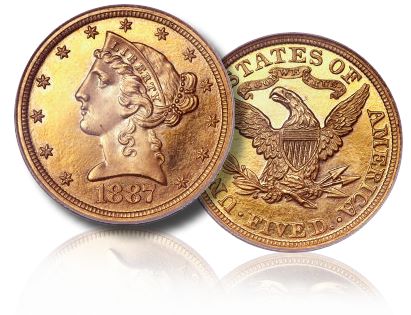 Proofs of this type are very collectible and range from exceedingly rare to rare-but-collectible.
Proofs of this type are very collectible and range from exceedingly rare to rare-but-collectible.
A type collector might want to acquire one example each of a Proof No Motto and With Motto Liberty Head half eagle. The former is very rare. Proofs were not issued in any sort of quantity until 1859. The Proofs produced in the 1860s are all very rare but can be obtained with patience. For a nice PR63 to PR64 example, a collector is looking at an investment in the $40,000-$50,000 range.
The With Motto Proofs were produced continuously from 1875 through 1907 (none were made in 1908). The 1875 and the 1887 are two dates that sell for large premiums; the former due to the rarity of business strikes and the latter due to the fact that it was made only in the Proof format.
As far as I know there are very few (if any) collectors are currently specializing in a date run of Proof Liberty Head half eagles. This would be a challenging and expensive set but one that could be completed. It is one that also contains coins that are great values. As an example, the Proofs from the late 1860s and early ’70s are extremely rare (typically fewer than a dozen are known) yet they do not command significant premiums in PR64 and PR65 over the more available issues from the 1880s and ’90s.
6. Varieties
If you are a collector who fancies varieties, there are more interesting ones present in the half eagles than any other Liberty Head series. These range from significant Red Book varieties to minor, little-known ones.
Some of the better-known varieties include the 1840 Broad Mill and Narrow Mill; the 1842 Small Letters and Large Letters; the 1842-C Small Date and Large Date; the 1842-D Small Date and Large Date; the 1843-O Small Letters and Large Letters; the 1846 Small Date and Large Date; and the 1846-D Normal Mintmark and D over D Mintmark. From 1850 onwards, there are fewer significant varieties.
There are only two confirmed overdates in the series and neither is rare. The 1881/0 and the 1901/0-S are both quite affordable in circulated grades and can be located in the lower to middling Uncirculated grades without much effort or expense.
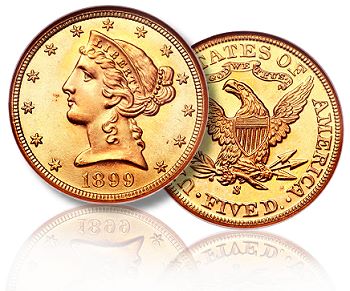 While I have done some fairly extensive research on the varieties of branch mint half eagles, there are probably a number waiting to be discovered. I think the most fertile area is probably the Philadelphia issues from the 1840s. This was an era in which countless blundered dates and other significant varieties are already known on silver coins; it seems likely that others await discovery in the half eagle series.
While I have done some fairly extensive research on the varieties of branch mint half eagles, there are probably a number waiting to be discovered. I think the most fertile area is probably the Philadelphia issues from the 1840s. This was an era in which countless blundered dates and other significant varieties are already known on silver coins; it seems likely that others await discovery in the half eagle series.
7. Further Thoughts
If you are new to the series, one of the real questions you may have is how to price Liberty Head half eagles. For the more common issues this isn’t very hard. You will find that many of the post-1880 issues from Philadelphia and San Francisco are regarded as “generics” and sell for little–if any–premium. Pricing the rarities is another story altogether.
If you decide to focus on the Southern branch mint coins, you will quickly learn that locating original pieces (i.e., examples with attractive natural coloration) is very difficult. Surprisingly, the premium factor for original coins is often low; in many cases only 5%-10% more than a bright, processed example. With many of the Charlotte, Dahlonega and New Orleans pieces, these issues are available in great enough numbers that the collector shouldn’t have to settle for a marginal quality coin.
Pricing very rare issues can be a challenge. There are some dates in the series that come on the market very infrequently and the last comparable trade at auction might have occurred as long as three to five years ago.
I just mentioned using auction comparables and I think this is a point worthy of a quick discussion. To my way of thinking, seeing what other examples of a coin have been bringing at auction is probably the best way to determine a price for a coin that you have an interest in. Let’s say, for example, that you are contemplating buying an 1847-O half eagle graded EF40. Let’s say that the last three auction trades are $5,290, $6,350 and $5,750. This gives a clear indication that a decent quality coin is going to be worth around $6,000. How about if you were to go back another two years and you see that there are three more trades; one for $11,500, one for $3,450, and another for $5,750? In the case of the $11,500 sale, I would dismiss this as it probably represents a coin that at least two bidders thought would upgrade. And the cheap sale of $3,450 probably represents a problem coin or one that is extremely low-end for the grade.
What are the best values in the Liberty Head half eagle series? That’s a hard question to answer as I believe that the entire series is chock full of good value. If I had to focus on a few areas that were the most undervalued I’d suggest No Motto Philadelphia coins in AU58 to MS62 (most are priced in the $1,000-5,000 range and harder to find than one might expect), the New Orleans issues in AU50 and above and the low-mintage Philadelphia issues from 1862 through 1877. But it’s hard to name just a few areas and I’d honestly say that just about any pre-1900 half eagle that is choice and original is desirable to some extent.
The Liberty Head half eagle series has become more and more popular over the years as people become aware of the challenges it offers collectors. I doubt if its appeal will ever become really widespread due to its longevity and cost but I look for it to become even more collected in the coming years.
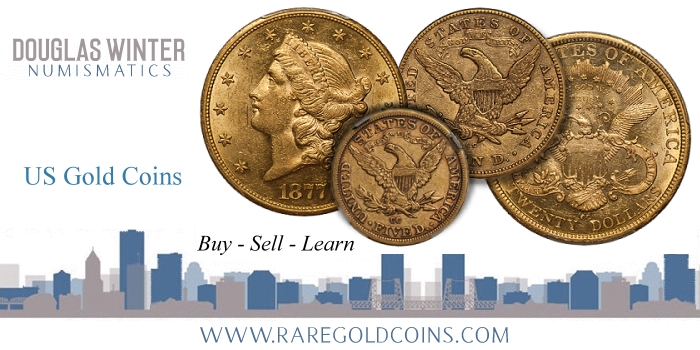
* * *





How can I know if my 1884 Liberty Head gold coin Is real?